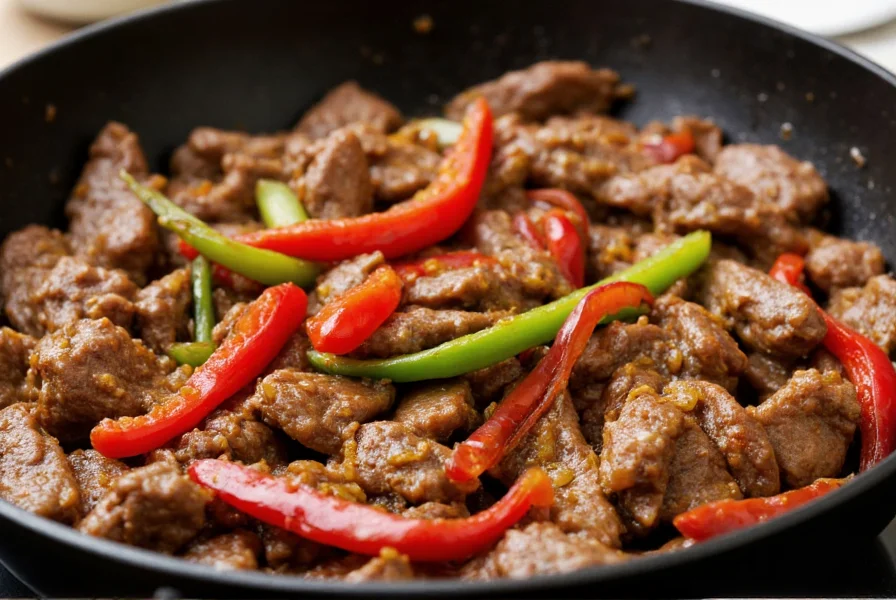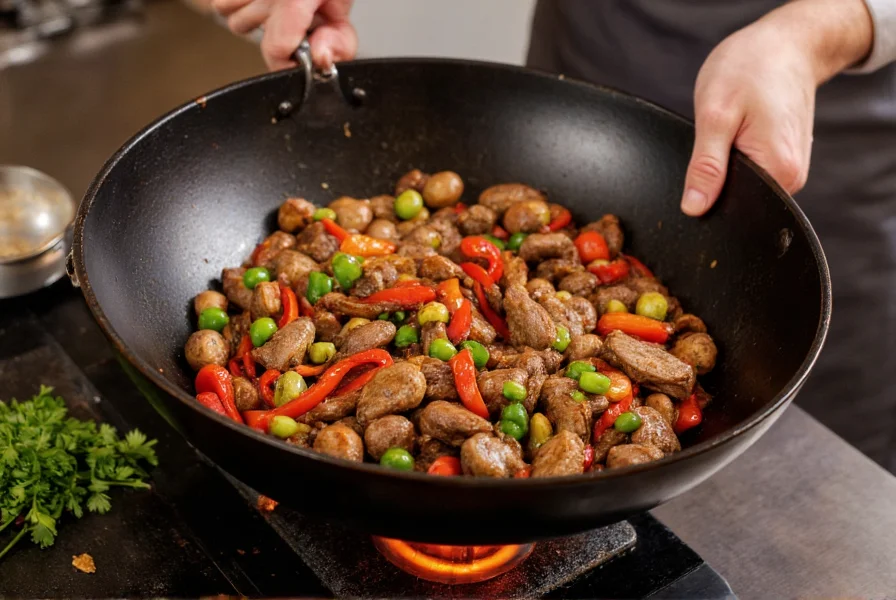The Ultimate Guide to Cooking Perfect Pepper Steak
Pepper steak remains a beloved weeknight favorite for good reason—it's quick, versatile, and delivers restaurant-quality results with minimal effort. This American-Chinese classic balances tender beef, vibrant vegetables, and a glossy sauce that transforms simple ingredients into something extraordinary. Understanding the proper technique separates a rubbery disappointment from a dish that rivals your favorite takeout.
Essential Ingredients for Authentic Pepper Steak
Quality ingredients form the foundation of exceptional pepper steak. While regional variations exist, these components create the perfect balance of flavors and textures:
| Ingredient | Quantity | Preparation Notes |
|---|---|---|
| Flank steak or sirloin | 1½ pounds | Sliced against the grain into ¼-inch strips |
| Bell peppers (mixed colors) | 3 medium | Sliced into 1-inch strips |
| Yellow onion | 1 large | Sliced into half-moons |
| Garlic | 3 cloves | Minced |
| Ginger | 1 tablespoon | Freshly grated |
| Soy sauce | 3 tablespoons | Low sodium preferred |
| Oyster sauce | 2 tablespoons | Essential for authentic flavor |
| Rice vinegar | 1 tablespoon | Adds brightness |
| Brown sugar | 1 teaspoon | Optional for balance |
| Cornstarch | 2 tablespoons | Divided for marinade and sauce |
| Sesame oil | 1 teaspoon | Added at the end |

Professional Technique: Step-by-Step Instructions
Mastering pepper steak requires understanding the sequence and timing. Follow these steps for consistently excellent results:
1. Prepare and Marinate the Beef
Slice your beef against the grain into ¼-inch strips—this breaks up muscle fibers for maximum tenderness. Combine beef with 1 tablespoon cornstarch, 1 tablespoon soy sauce, and 1 teaspoon sesame oil. Massage gently and let marinate for 15-20 minutes while preparing other ingredients. This simple step makes a dramatic difference in texture.
2. Create the Perfect Sauce
While beef marinates, whisk together 2 tablespoons soy sauce, 2 tablespoons oyster sauce, 1 tablespoon rice vinegar, 1 teaspoon brown sugar (if using), and 1 tablespoon cornstarch with ¼ cup water or broth. The cornstarch-water mixture creates the ideal consistency when heated—thick enough to coat the ingredients but not gloppy.
3. High-Heat Stir-Frying Technique
Heat 2 tablespoons oil in a wok or large skillet over high heat until shimmering. Add beef in a single layer (work in batches if necessary) and sear for 1-2 minutes per side until browned but not fully cooked. Remove beef immediately—this prevents overcooking. Add another tablespoon of oil if needed, then stir-fry onions and bell peppers for 2-3 minutes until crisp-tender with slight charring.
4. Combine and Finish
Return beef to the skillet with garlic and ginger, stirring constantly for 30 seconds until fragrant. Give your sauce a quick stir (cornstarch settles) and pour it into the center of the wok. Stir constantly as the sauce thickens and becomes glossy, about 1 minute. The entire cooking process should take no more than 5 minutes once sauce is added.

Critical Success Factors for Perfect Pepper Steak
Achieving restaurant-quality pepper steak at home requires attention to these often-overlooked details:
Beef Selection and Preparation
Flank steak offers excellent flavor but requires proper slicing against the grain. Sirloin provides more tenderness but at a higher cost. Never use stew meat or pre-cut 'stir-fry beef'—these contain tougher cuts that won't yield the same results. The 15-minute cornstarch marinade creates a protective barrier that seals in juices during high-heat cooking.
Temperature Control
Many home cooks fail by not heating their pan sufficiently. Your wok should be nearly smoking before adding oil, which should shimmer immediately. This high heat creates the Maillard reaction essential for flavor development without overcooking the beef. If your vegetables are steaming rather than sizzling, your heat is too low.
Sauce Consistency Mastery
The ideal pepper steak sauce should coat the back of a spoon but still flow smoothly. If too thin, mix additional cornstarch with cold water (1:1 ratio) and add gradually. If too thick, add splashes of broth or water. Remember that sauce continues thickening slightly after removal from heat.
Common Mistakes to Avoid
Even experienced cooks make these pepper steak pitfalls:
- Overcrowding the pan—leads to steaming instead of searing
- Cooking vegetables too long—they should remain crisp with slight crunch
- Adding sauce too early—causes beef to overcook before sauce thickens
- Using cold ingredients—lowers pan temperature dramatically
- Skipping the cornstarch marinade—results in less tender beef
Variations and Customizations
Once you've mastered the classic preparation, consider these authentic variations:
- Szechuan style—add 1 teaspoon Szechuan peppercorns and 1 tablespoon chili garlic sauce
- Honey pepper steak—increase brown sugar to 2 tablespoons and add 1 tablespoon honey
- Vegetarian alternative—substitute beef with extra-firm tofu or seitan
- Spicy kick—add 1-2 thinly sliced fresh red chilies with the vegetables
Serving and Storage Recommendations
Pepper steak performs best when served immediately over steamed jasmine rice or noodles. For meal prep, store components separately—beef and vegetables in one container, sauce in another—to prevent sogginess. Properly stored in airtight containers, pepper steak maintains quality for 3-4 days in the refrigerator. Reheat gently in a skillet with a splash of water to restore moisture—microwaving often makes the beef tough.
Frequently Asked Questions
What's the best cut of beef for pepper steak?
Flank steak provides the ideal balance of flavor and value for pepper steak, but requires proper slicing against the grain. Sirloin offers more tenderness but at a higher price point. Avoid tougher cuts like chuck or round, which won't yield the same texture even with proper preparation techniques.
Why does my pepper steak turn out tough?
Tough pepper steak typically results from three common errors: slicing with the grain instead of against it, overcooking the beef, or using insufficient cornstarch in the marinade. Ensure you slice against the grain, sear quickly over high heat, and use the cornstarch marinade technique to protect the meat during cooking.
Can I make pepper steak without a wok?
Absolutely. While a wok provides ideal heat distribution, a large cast-iron or carbon steel skillet works exceptionally well for pepper steak. The critical factor is using a pan that can maintain high heat without temperature drops when ingredients are added. Avoid non-stick pans for this application as they cannot reach the necessary temperatures for proper searing.
How can I make my pepper steak sauce less salty?
To reduce saltiness in pepper steak sauce, use low-sodium soy sauce and balance with additional rice vinegar (½-1 tablespoon) or a small amount of brown sugar. You can also dilute with unsalted broth or water. For future batches, consider replacing 1 tablespoon of soy sauce with dry sherry, which provides umami without additional salt.
What vegetables work best in pepper steak besides bell peppers?
While bell peppers are traditional, you can enhance your pepper steak with sliced mushrooms, baby corn, water chestnuts, or snap peas. Add these during the vegetable stir-fry stage, adjusting cooking times based on density—mushrooms need 3-4 minutes while snap peas require just 1-2 minutes to maintain crispness.










 浙公网安备
33010002000092号
浙公网安备
33010002000092号 浙B2-20120091-4
浙B2-20120091-4